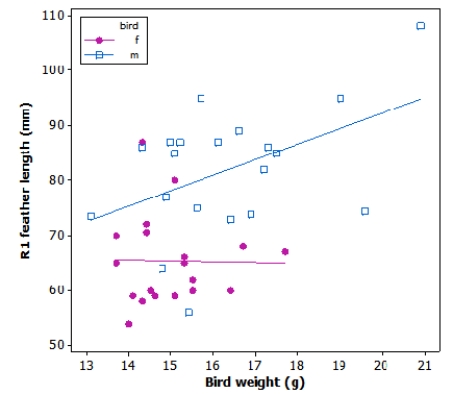Multiple Choice
Tail-feather length in birds is sometimes a sexually dimorphic trait. That is, the trait differs substantially for males and for females. Researchers studied the relationship between tail-feather length (measuring the R1 central tail feather) and weight in a sample of 20 male and 21 female long-tailed finches raised in an aviary. What is a practical interpretation of the slope estimate of the least squares regression line for males (blue squares) ?
What is a practical interpretation of the slope estimate of the least squares regression line for males (blue squares) ?
A) For each additional gram of weight, we estimate the tail feather length to increase by 3 mm, on average.
B) For each additional gram of weight, we estimate the tail feather length to increase by 70 mm, on average.
C) For each additional millimeter of length of tail feather, we estimate weight to increase by 3 g, on average.
D) For each additional millimeter of length of tail feather, we estimate weight to increase by 70 g, on average.
Correct Answer:

Verified
Correct Answer:
Verified
Q24: Suppose we fit the least-squares regression line
Q25: One of nature's patterns connects the
Q26: What is the best description of a
Q27: Before surgical removal of a diseased parathyroid
Q28: Before surgical removal of a diseased parathyroid
Q30: In a study of diet, the amount
Q31: Tail-feather length in birds is sometimes
Q32: A researcher wants to determine whether the
Q33: A researcher noticed that, for streams along
Q34: Tail-feather length in birds is sometimes a